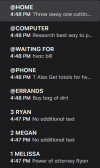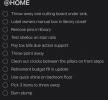KatyP
Registered
I've been running into this problem any time I've tried to stick with using GTD. I have a lot of different projects that I need to make progress on. But I become overwhelmed and I am not sure how to efficiently look through the different tasks I might want to be working on today. I don't want to review all my projects every day, that's a lot of work. I use Things, and I started tagging the projects and tasks with the tag "SOON" that I need to make a lot of progress on with in the near future or things that are time sensitive, so I can search for that tag and then pull some of those tasks into what I plan to work on today. But even that list gets overwhelming.
Also I'll end up with a bunch of tasks in Today that I didn't get to, which gets carried over to the next day. So they shouldn't really be in Today unless they will definitely get done today. But I don't want to go through this processes several times a day to put tasks into today.
I know that if we have some projects we are not really working on currently that we can move them into a "Someday / Maybe" lists. And I have a "Someday Soon", "Someday Later", and "Someday Maybe" lists.
But it's specifically the plethora of projects I need to be making some consistent progress on that overwhelm me.
Any thoughts on how to go about deciding what to work on every day without getting overwhelmed and also not dropping the ball on making progress on many projects?
Also I'll end up with a bunch of tasks in Today that I didn't get to, which gets carried over to the next day. So they shouldn't really be in Today unless they will definitely get done today. But I don't want to go through this processes several times a day to put tasks into today.
I know that if we have some projects we are not really working on currently that we can move them into a "Someday / Maybe" lists. And I have a "Someday Soon", "Someday Later", and "Someday Maybe" lists.
But it's specifically the plethora of projects I need to be making some consistent progress on that overwhelm me.
Any thoughts on how to go about deciding what to work on every day without getting overwhelmed and also not dropping the ball on making progress on many projects?



